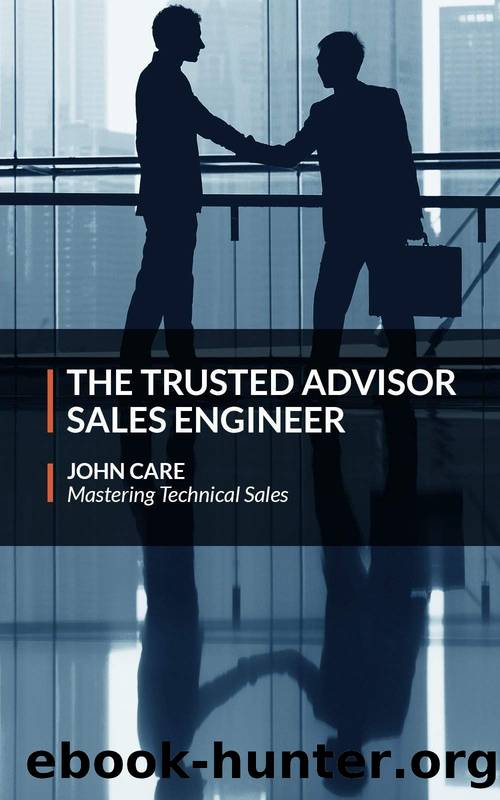The Trusted Advisor Sales Engineer by John Care

Author:John Care
Language: eng
Format: azw3
Tags: Business
ISBN: 9781099750397
Publisher: Mastering Technical Sales
Published: 2016-07-12T05:00:00+00:00
The Five Factors
Credibility. As mentioned above, the fact that you are willing to take a little risk and draw your solution or idea or even facilitate a meeting does wonders for your credibility. The downside is that you definitely have to know your material, as you donât have a bunch of bullet points on a PowerPoint slide to use as a presentation crutch. The upside is that you gain the flexibility to adapt to the client and the collaboration to work with them instead of present to them. As a starting point practice being able to design and deliver your own personalized 6-8 minute vignette pitch on a number of topics. A good selection would be a big picture, overall value proposition, architecture overview and a diagram/explanation of some competitive differentiators.
Reliability. One of the more advanced characteristics of Reliability is anticipation. Be prepared for questions the customer may have, anticipate a âwhat-ifâ solution to a new problem. If you know your solution well enough and have sufficient customer examples you can whiteboard almost anything. Remember that nothing you draw is going to hang in the Louvre or Tate Gallery; it just has to be good enough to get your point across so that the customer can both remember it and understand it.
Intimacy. One part of intimacy is being to communicate in the manner that is easiest for the customer â which puts them at ease and makes them naturally more receptive to your thoughts. According the Visual Teaching Alliance[11], 65% of the population are visual learners so itâs a method to personalize and customize for your client. In a small setting (i.e. 1:1 or 1:2) visualization is a great way to pull your client out of a formal office environment and have a conversation in the cafeteria or a coffee shop. In an even larger group setting (i.e. 1:3 to 1:8) you can still get everyone engaged up at a board and eliminate the email distraction.
Self. Much as with any other communications mechanism, you need to be aware of the difference between a presentation and a conversation. Provide your audience plenty of opportunity to agree, to modify and even to redraw part of the sketch. When used at an appropriate part of the sales cycle, it encourages collaboration and buy-in because a joint diagram becomes a joint solution, and thatâs a massive psychological step forwards. In situations when I want to encourage collaboration I make a point of putting spare markers on the table for the audience to use, or else I give my client their own pen if Iâm in a 1-on-1 situation. Itâs about empowerment.
Download
This site does not store any files on its server. We only index and link to content provided by other sites. Please contact the content providers to delete copyright contents if any and email us, we'll remove relevant links or contents immediately.
| Advertising | Consumer Behavior |
| Customer Service | Marketing |
| Public Relations | Sales & Selling |
| Search Engine Optimization |
Influence: The Psychology of Persuasion by Robert B. Cialdini(4716)
The Miracle Morning by Hal Elrod(4638)
The Hacking of the American Mind by Robert H. Lustig(4319)
Pre-Suasion: A Revolutionary Way to Influence and Persuade by Robert Cialdini(4151)
Unlabel: Selling You Without Selling Out by Marc Ecko(3591)
Ogilvy on Advertising by David Ogilvy(3512)
Hidden Persuasion: 33 psychological influence techniques in advertising by Marc Andrews & Matthijs van Leeuwen & Rick van Baaren(3474)
Purple Cow by Seth Godin(3142)
Who Can You Trust? by Rachel Botsman(3089)
Kick Ass in College: Highest Rated "How to Study in College" Book | 77 Ninja Study Skills Tips and Career Strategies | Motivational for College Students: A Guerrilla Guide to College Success by Fox Gunnar(3077)
The Marketing Plan Handbook: Develop Big-Picture Marketing Plans for Pennies on the Dollar by Robert W. Bly(2977)
This Is Marketing by Seth Godin(2974)
I Live in the Future & Here's How It Works by Nick Bilton(2938)
The Power of Broke by Daymond John(2900)
Building a StoryBrand by Donald Miller(2843)
The Tipping Point by Malcolm Gladwell(2828)
The 46 Rules of Genius: An Innovator's Guide to Creativity (Voices That Matter) by Marty Neumeier(2797)
Draw to Win: A Crash Course on How to Lead, Sell, and Innovate With Your Visual Mind by Dan Roam(2739)
Market Wizards by Jack D. Schwager(2644)
